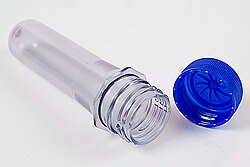


A plastic bottle is a bottle constructed from high-density or low-density plastic. They are typically used to store liquids such as water, soft drinks, motor oil, cooking oil, medicine, shampoo or milk. They range from very small bottles to large carboys. Consumer blow molded containers often have integral handles or are shaped to facilitate grasping. [2] [3]
Contents
- Production
- Petrochemical resins
- Other materials
- Concerns
- Microplastics
- Labelling
- Speciality types
- Collapsible bottle
- Carbonated drinks bottles
- See also
- References
- Books
- External links
Plastic was invented in the nineteenth century and was originally used to replace common materials such as ivory, rubber, and shellac. [4] Plastic bottles were first used commercially in 1947, but remained relatively expensive until the early 1950s, when high-density polyethylene was introduced. [5] They quickly became popular with manufacturers and customers because, compared to glass bottles, they are lighter, cheaper and easier to transport. [6] [7] [8] However, their greatest advantage over glass bottles is their superior resistance to breakage, in both production and transportation. Except for wine and beer, the food industry internationally has largely replaced glass bottles with plastic bottles.



